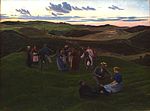Fritz Syberg
Christian Friedrich Wilhelm Heinrich Syberg , known as Fritz Syberg , (born July 28, 1862 in Fåborg , † December 20, 1939 in Kerteminde ) was a Danish painter and illustrator. He gained fame as a co-founder of the Fyn painters ' colony .
biography
Syberg came from a rather poor background and completed an apprenticeship as a house painter in Faaborg under Syrak Hansen, the father of Peter Hansen, a future friend and co-founder of the Funen painters. In 1882 he attended the technical school in Copenhagen and learned to paint under Holger Grønvold. After a short stay at the Royal Danish Academy of Art (spring 1884) he attended the Kunstnernes Frie Studieskoler (1885-1891), where he was the first of the Funen painters to paint under Kristian Zahrtmann . He traveled to Sweden (1899), where he visited Johannes Larsen, Germany (1902), Italy (1905) together with Jens Birkholm, the Netherlands and Paris (1908) and Pisa (1910–1913). Syberg married Peter Hansen's sister Anna Hansen in 1894 and after her death in 1914 her sister Marie Hansen in 1915. He was the father of the artist Ernst Syberg and the composer Franz Syberg.
Artistic career
Together with Johannes Larsen, Poul S. Christiansen and Peter Hansen, he was one of the first Fyn painters who, under Zahrtmann, broke with the Danish tradition and examined the new artistic directions of naturalism and realism . Initially, Syberg was very much influenced by Zahrtmann's use of color, which can be seen in Dødsfald (1892), a picture depicting the death of his mother 14 years earlier in Faaborg. After he married Peter Hansen's sister, Anna Hansen, his pictures became lighter, as can be seen in his landscapes and the 18 illustrations (1895–1898) for Hans Christian Andersen's work The Story of a Mother . His oil paintings include Dødens komm (1906) and Døden ved vuggen (1907) and landscapes of Funen, first around Dyreborg and Svanninge, as can be seen in Forår (1893) or Aftenleg i Svanninge Bakker (1900), later around Kerteminde and Møllebakken, where his garden and his children are among the main subjects.
Syberg started painting with watercolors at a very early age, but only completed the style during his three-year stay with his family in Pisa. Then he made a new series of water color pictures that had never been seen before in Denmark. Through the wedding of his daughter Besse Syberg, he came into contact with a younger generation of Danish painters who followed a more modernist approach. He turned back to oil painting like Overkærby Bakke Vinter (1917). His son Ernst Syberg later also became an artist.
Selected Works

- Rugmark ved Svanninge (1887)
- Dødsfald (1892)
- Forår (1893)
- Histories om en moder (18 drawings, 1895–1898)
- Aftenlegg i Svanninge Bakker (1900)
- Børnene på Fyns Hoved (1905)
- Mor og datter ved Hverringe Strand (1906)
- Dødens come (1906)
- Døden ved vuggen (1907)
- Sommerhytterne. Korshavn (1910)
- Efter bathes, Italy (1911)
- Overkarby Bakke. Vinter (1917)
- Ved Morning Cafes (1919)
- Composers (1936)
gallery
Web links
- ArtNet: More works by Syberg
Individual evidence
- ^ Vera Rasmussen, Fritz Syberg , Kunstindeks Danmark & Weilbachskunstnerleksikon . Retrieved in Danish on 11 August 2011.
- ^ Hans-Edvard Nørregård-Nielsen: Dansk art. Guldendalske Boghandel, Nordisk Forlag, Copenhagen 2006.
- ^ Fritz Syberg In: The Store Danske. ( Danish ) Retrieved August 11, 2011.
- ↑ Ernst Syberg. In: The Danske store. Retrieved October 3, 2014 (Danish).
| personal data | |
|---|---|
| SURNAME | Syberg, Fritz |
| ALTERNATIVE NAMES | Syberg, Christian Friedrich Wilhelm Heinrich (full name) |
| BRIEF DESCRIPTION | Danish painter and illustrator |
| DATE OF BIRTH | July 28, 1862 |
| PLACE OF BIRTH | Fåborg |
| DATE OF DEATH | December 20, 1939 |
| Place of death | Kerteminde |




